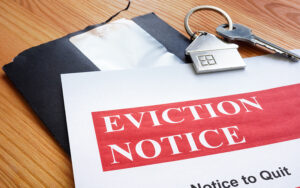A tenant smoking in a rental property can be a huge problem for a landlord. But how can you prove that your tenant has violated your no-smoking policy? And what can you do to address it?
Is Your Tenant Smoking? Here’s How to Tell

Many rental properties have no-smoking policies for a number of reasons. First, smoking is a fire hazard and can raise insurance premiums. When you allow smoking in your rental, your insurance provider will likely charge more to cover fire-related risks.
Second, smoking can leave nasty odors and stains. It can also cause property damage in the form of a fire or burn marks. For a landlord, dealing with these issues every time a tenant moves out can be very costly and time-consuming.
Finally, smoking poses health concerns. While smokers may not be too worried about their own health, their neighbors might be. Secondhand smoke is a real threat to heart and respiratory health, and any level of exposure to it can cause adverse effects.
But, even with ironclad smoking restrictions, there are just some tenants who think they can get away with smoking every now and then or who disregard the rules completely. If you want to catch your tenant smoking, here are some signs to watch out for.
1. The Smell
Smoking, whether it’s tobacco or marijuana, gives off a unique stench. Both are very pungent and, if you have ever been exposed to them, are immediately identifiable. Even if a tenant opens the windows or uses perfume to mask the odor, you can still smell smoke in a room long after the tenant stops smoking.
2. The Smoke
Apart from the olfactory aspect, you can detect smoke visually. Smoking omits a haze, especially in a closed setting. Because smoke dissipates rather quickly, though, you can’t really catch a tenant smoking through just the smoke alone.
3. The Butts
Another thing to look out for is cigarette or marijuana butts. When conducting routine inspections, check for the butt ends of cigarettes or joints in ashtrays or trash bins. Sometimes, a sneaky tenant will throw these out prior to an inspection, so check nearby bins as well.
4. The Residue
Even if your tenant throws away the butts, there may still be residue from the cigarettes or blunts lying around. Look for ash on window sills, shelves, sinks, and other surfaces.
5. The Burn Marks
Burn marks are another surefire sign that your tenant is smoking. These are usually apparent if you have a careless tenant. Look for burn marks on furniture, carpets, and upholstery. Your tenant may attempt to cover these marks with a pillow or blanket, but it’s hard to completely get rid of them without professional help.
6. The Stains
Cigarette and marijuana smoke can discolor walls, door frames, counters, curtains, and lamps. Depending on how often your tenant smokes, these stains can range from yellow to brown. You might see them in small patches, especially if your tenant likes to smoke in a particular area of the unit, but they can also leave larger stains.
Using Technology to Identify a Tenant Smoking in Rental
 Some signs of smoking are obvious and easy to prove, while others are not. Landlords can even face certain legal issues if they accuse a tenant without basis. Unfortunately, definitive proof is not always present. Your tenant could be exceptionally good at covering their tracks.
Some signs of smoking are obvious and easy to prove, while others are not. Landlords can even face certain legal issues if they accuse a tenant without basis. Unfortunately, definitive proof is not always present. Your tenant could be exceptionally good at covering their tracks.
Technology has advanced greatly within the last few decades, though. Today, there are sensors specifically designed to detect the presence of tobacco or marijuana smoke in spaces. Some are less advanced and only use light or radiation to detect smoke particles. However, there are many sensors on the market that detect specific molecules found in tobacco or marijuana smoke. Several are even tamper-proof.
As a landlord, you can invest in these sensors and install them in units as well as common spaces. You can usually just plug them in and connect them to your Wi-Fi network. Then, when a sensor detects smoke, it will send you a notification (via email or push notifications) in real time.
How to Address a Tenant Smoking Problem
Once you have determined that your tenant is smoking, you can take the next steps. Here’s how you can address a tenant smoking in a no-smoking rental.
1. Make Sure It’s in the Lease
First, make sure you have a no-smoking policy written in your lease agreement. If it is not in your lease, then you likely can’t prohibit your tenant from smoking in the first place.
For fixed-term leases, landlords can’t add a new rule in the middle of a tenancy. The exception to this is if the tenant agrees to the new rule in writing. For month-to-month leases, a landlord must give proper notification of the new rule to the tenant. The notification period depends on where you are, though it is usually 30 days.
While smoking is not an inherently illegal act, it is also not a right protected by law. As such, landlords do have the power to impose and enforce a no-smoking policy, provided it appears in the lease. This also applies to marijuana, even in states where marijuana use is legal.
2. Send a Smoking Violation Letter
Depending on your lease agreement, you may send a “no smoking” letter to tenants who violate the no-smoking policy. This letter should contain the nature of the violation as well as the time and date it took place. It should also cite the part of the lease agreement that it violates. Sometimes, a landlord will only issue a warning and give the tenant a chance to remedy the problem.
3. Charge a Fine
Depending on state laws and your lease agreement, you may be able to charge a fine every time your tenant smokes. This is especially common for short-term rentals on Airbnb and Vrbo. Some tenants, though, are willing to take the risk and pay the fine.
 4. Evict the Tenant
4. Evict the Tenant
Can you evict a tenant for smoking? If your lease agreement prohibits smoking, then you can certainly evict your tenant for smoking since it violates the lease. Eviction proceedings can be expensive and time-consuming, though, so many landlords seek professional help when it comes to evictions.
Preventive Measures a Landlord Can Take
To limit the chances of a tenant smoking in your rental, there are certain measures you can take right from the get-go. For instance, when advertising your rental, make it clear in the listing that smoking is prohibited. Let potential tenants know from the start that you don’t allow smoking inside the unit (or even in common areas).
Not all potential tenants read through the entire listing, though. As such, it is important to reiterate your no-smoking policy throughout the application process, too. From property showings to filling out the application itself, let applicants know that you don’t allow smoking.
To be extra careful, discuss the rule again before signing the lease. Then, point out where in the lease agreement this exact rule appears. This will ensure that tenants know you have a zero-tolerance policy on smoking.
As an added precaution, you may also want to post “no smoking” signs on the premises. There is a sizable smoking population in the United States. If you don’t want to miss out on renting to that demographic, you might consider assigning a designated smoking area.
A Standard Practice
When it comes to tenant smoking, the rules are pretty standard. As long as your lease agreement restricts smoking, you have the legal grounds to prevent a tenant from taking part in the act while on the rental property. If you find that a tenant has violated this clause, there are several ways to address it, as evidenced above.
Property management, including dealing with smokers, can be difficult. Get help from an experienced property management company. Browse our online directory today to start looking for one in your area!
RELATED ARTICLES: